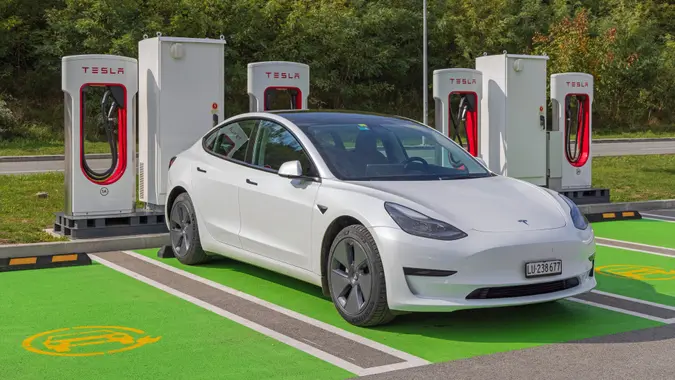I Asked ChatGPT How Much I Should Spend on the Holidays Based on My Current Finances: It Said $1,100

Commitment to Our Readers
GOBankingRates' editorial team is committed to bringing you unbiased reviews and information. We use data-driven methodologies to evaluate financial products and services - our reviews and ratings are not influenced by advertisers. You can read more about our editorial guidelines and our products and services review methodology.

20 Years
Helping You Live Richer

Reviewed
by Experts

Trusted by
Millions of Readers
ChatGPT’s explosive popularity among Americans (and really, global citizens) from all walks of life has heralded in an age of commonplace artificial intelligence (AI) usage — so why not leverage the large language model’s skill set in building an appropriate holiday budget as summer draws to a close?
For the majority of this exercise, the median middle-class household income in the U.S. (pegged at about $75,000 in 2025, per Visual Capitalist) was posed to ChatGPT, as well as the 2024 average household debt of $105,056 (according to The Motley Fool), to provide a balanced financial portrait.
A more concise examination of lower-income and higher-income household spending budgets — still falling within the relative definition of middle class based on state averages — will be presented following the primary results.
Also see three ways to “tariff-proof” your holiday spending.
ChatGPT: Middle-Class Households Should Aim To Spend $1,100 This Holiday Season
ChatGPT was asked to provide a list of “necessities” as well as “nice-to-haves” when providing its analysis of holiday spending.
The first thing the AI model noted: It’s wise to contain your holiday spending to anywhere between 1% and 2% of your annual household income. In this case, ChatGPT produced a budget nearly square in the middle, at 1.46% of $75,000 (or about $1,100), including a $120 “debt reduction” buffer to service or reduce interest payments, which don’t stop due to wintry weather nor holiday cheer.
Under the necessities category, ChatGPT broke out the following line items, totaling $900:
- Gifts for immediate family and closest friends ($500): This includes gifts for children ($125 each, based on two children, totaling $250); one’s spouse or partner ($125); both sides of the in-law equation ($75); and close friends or siblings ($50). This spending is “still thoughtful, but pared down to keep costs contained,” according to ChatGPT.
- Holiday meals and groceries ($180): This includes holiday dinner or supper ingredients ($110), as well as baking ingredients, snacks on hand and hosting event food ($70). “Shop strategically. Home cooking beats catering,” the AI urged.
- Travel to visit family ($150): Gas and modest lodging was pegged at $150.
- Decorations and hosting basics ($70): Reusing past decor and DIY efforts wherever possible is wise, but a budget of $70 was still outlined for this category to provide a “seasonal feel without overspending.”
And concerning the nice-to-haves, it provided these items at an additional $80 in sum:
- Experiences and outings ($40): At $40, expectations should be low here. A light festival, family skating at the local rink or a cheap movie night (bring your own snacks) were mentioned as possibilities.
- Gifts for co-workers or neighbors ($20): A modest $20 was budgeted here, which may be best spent on consumables such as cookies or candles.
- Charitable donation ($20): A single donation of $20 could add some cheer to your local charity of choice.
Lower- and Higher-Income Household Holiday Spending Budgets
When asked to substitute the lower boundaries and higher boundaries for what defines the American middle class on a state-by-state basis, ChatGPT produced the following figures.
- Lower boundary of middle class, $36,000 (as in Mississippi): Necessities budgeted in at $320 ($150 for gifts) and $30 for debt servicing or nice-to-haves, for a total of $350.
- Upper boundary of middle class, $200,000 (as in Massachusetts): Necessities budgeted in at $2,600 ($1,600 for gifts) and $400 for nice-to-have items or debt payments, for a sum of $3,000.
 Written by
Written by  Edited by
Edited by 


























